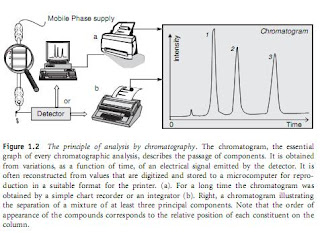Chromatography is a physico-chemical method of separation of components within mixtures, liquid or gaseous, in the same vein as distillation, crystallization, or the fractionated extraction. The applications of this procedure are therefore numerous since many of heterogeneous mixtures, or those in solid form, can be dissolved by a suitable solvent (which becomes, of course, a supplementary component of the mixture).
A basic chromatographic process may be described as follows (Figure 1.1):
1. A vertical hollow glass tube (the column) is filled with a suitable finely powdered solid, the stationary phase.
2. At the top of this column is placed a small volume of the sample mixture to be separated into individual components.
3. The sample is then taken up by continuous addition of the mobile phase, which goes through the column by gravity, carrying the various constituents of the mixture along with it. This process is called elution. If the components migrate at different velocities, they will become separated from each other and can be recovered, mixed with the mobile phase.
A basic chromatographic process may be described as follows (Figure 1.1):
1. A vertical hollow glass tube (the column) is filled with a suitable finely powdered solid, the stationary phase.
2. At the top of this column is placed a small volume of the sample mixture to be separated into individual components.
3. The sample is then taken up by continuous addition of the mobile phase, which goes through the column by gravity, carrying the various constituents of the mixture along with it. This process is called elution. If the components migrate at different velocities, they will become separated from each other and can be recovered, mixed with the mobile phase.
 This basic procedure, carried out in a column, has been used since its discovery on a large scale for the separation or purification of numerous compounds (preparative column chromatography), but it has also progressed into a stand-alone analytical technique, particularly once the idea of measuring the migration times of the different compounds as a mean to identify them had been conceived, without the need for their collection. To do that, an optical device was placed at the column exit, which indicated the variation of the composition of the eluting phase with time. This form of chromatography, whose goal is not simply to recover the components but to control their migration, first appeared around 1940 though its development since has been relatively slow.
This basic procedure, carried out in a column, has been used since its discovery on a large scale for the separation or purification of numerous compounds (preparative column chromatography), but it has also progressed into a stand-alone analytical technique, particularly once the idea of measuring the migration times of the different compounds as a mean to identify them had been conceived, without the need for their collection. To do that, an optical device was placed at the column exit, which indicated the variation of the composition of the eluting phase with time. This form of chromatography, whose goal is not simply to recover the components but to control their migration, first appeared around 1940 though its development since has been relatively slow.The identification of a compound by chromatography is achieved by comparison: To identify a compound which may be A or B, a solution of this unknown is run on a column. Next, its retention time is compared with those for the two reference compounds A and B previously recorded using the same apparatus and the same experimental conditions. The choice between A and B for the unknown is done by comparison of the retention times.
In this experiment a true separation had not been effected (A and B were pure products) but only a comparison of their times of migration was performed. In such an experiment there are, however, three unfavourable points to note: the procedure is fairly slow; absolute identification is unattainable; and the physical contact between the sample and the stationary phase could modify its properties, therefore its retention times and finally the conclusion.
This method of separation, using two immiscible phases in contact with each other, was first undertaken at the beginning of the 20th century and is credited to botanist Michaël Tswett to whom is equally attributed the invention of the terms chromatography and chromatogram.
The technique has improved considerably since its beginnings. Nowadays chromatographic techniques are piloted by computer software, which operate highly efficient miniature columns able to separate nano-quantities of sample. These instruments comprise a complete range of accessories designed to assure reproducibility of successive experiments by the perfect control of the different parameters of separation. Thus it is possible to obtain, during successive analyses of the same sample conducted within a few hours, recordings that are reproducible to within a second (Figure 1.2).
The essential recording that is obtained for each separation is called a chromatogram. It corresponds to a two-dimensional diagram traced on a chart paper or a screen that reveals the variations of composition of the eluting mobile phase as it exits the column. To obtain this document, a sensor, of which there exists a great variety, needs to be placed at the outlet of the column. The detector signal appears as the ordinate of the chromatogram while time or alternatively elution volume appears on the abscissa.
The identification of a molecular compound only by its retention time is somewhat arbitrary. A better method consists of associating two different complementary methods, for example, a chromatograph and a second instrument on-line, such as a mass spectrometer or an infrared spectrometer. These hyphenated techniques enable the independent collating of two different types of information that are independent (time of migration and ‘the spectrum’). Therefore, it is possible to determine without ambiguity the composition and concentration of complex mixtures in which the concentration of compounds can be of the order of nanograms.
